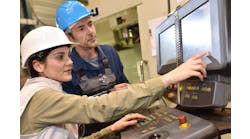Foundation Shaken, Toyota Aims to Restore Credibility
The opening ceremonies of the Winter Olympics had no shortage of spectacle. But one of the most poignant moments had nothing to do with sports or pageantry, but came during a 30 second spot from one of its sponsors.
Toyota, one of a dozen automakers sponsoring television coverage for the Olympics, offered a mea culpa of sorts for its string of recalls, which have now totaled more than eight million vehicles worldwide.
"Recently, our company hasn't been living up to the standards that you've come to expect from us or that we expect from ourselves," says an announcer, while a series of images show a father flanked by his wife and children, presumably from the 1960s, shaking hands with a Toyota dealer, and American workers in factories assembling new cars. The automaker, the announcer says, has taken bold steps "to restore your faith in our company."
The media campaign is one small part of Toyota's larger effort to restore what until this year had been perhaps its greatest public asset: credibility. But rebuilding that trust will require extraordinarily deep levels of internal assessment, say several experts in the field.
"You don't establish credibility through PR spin," says John Shook, a senior advisor at the Lean Enterprise Institute (LEI). "You establish credibility through integrity and accomplishing deeper levels of integration."
| Insider's Look offers exclusive commentary and analysis by digging deep into the stories that most affect manufacturers. IW Associate Editor Peter Alpern talks with manufacturing executives on the ground as well as industry experts about the trends and challenges the manufacturing sector faces. See the latest in this continuing series. Also see our other Toyota Brake Recall Articles |
But according to Shook, the embattled automaker is facing the same set of challenges that any number of companies before them have faced: coordinating efforts and maintaining an efficiency and quality on a global scale.
"I think that what's happening here is an indication of how difficult it is to maintain integration on a global scale," says LEI's Shook. "It's a problem no company has really conquered. Back in the day, functional expertise was fairly simple and geographically was more contained. But today, in terms of technology, scale and geography, the challenges are exponentially greater."
There may also be deeper, more inherent flaws within Toyota's structure, says Joseph Grenny, co-founder of organizational consultancy group VitalSmarts. In many cases, schedule pressures and the demand to operate at a productive rate undermine workers from speaking up about visible flaws in a system, especially at the lower levels of an organization, says Grenny.
"What we've found in our research is that a culture of silence permeates and that makes incidents like at Toyota almost inevitable," says Grenny. "People develop a complacent attitude about speaking up the chain of command. And leaders have to take extraordinary measures to combat it."
Toyota's production system, hailed as the most sophisticated process in across business, is meant to design out overburdening employees and empower workers at the lowest level of an organization to look for inefficiencies.
According to Grenny, when a workforce becomes disengaged, there is a loss in quality and safety. He cites several measures companies, such as Toyota, can take to combat this, among them, emphasizing the value of safety and good decision making, training an entire workforce to speak up as a skill, bringing positive attention to those that display the right behavior, making accessibility visible on the floor, rewarding those that are candid with promotions and investing in strong IT systems and infrastructure for surfacing problems.
Exposing inefficiencies and correcting problems has largely been Toyota's strength. The harder question may lay in the long-term challenge the automaker faces in restoring its public credibility.
"I don't think we've ever before seen a company that was held in such high esteem from a brand standpoint and suddenly lose its credibility so quickly," says LEI's John Shook. "In some ways, they were slow and there seemed to be incomplete messages in what they were saying early on.
"Assuming they've laid out publicly how they're going to tackle the problem and they follow through with it, what they're going to do is undergo a detailed analysis," he adds. "It needs to be carried out not just by a small group of people, but across a lot of different boundaries. Accomplishing deeper levels of integration is what's going to help them reestablish and confirm their integrity."
See AlsoAll Toyota Brake Recall Articles



